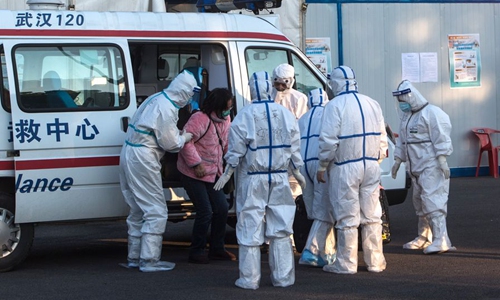Hubei moving in right direction after new clinical diagnosis methods push up confirmed cases: epidemiologist

Medical staff receive a patient infected with the novel coronavirus at the temporary hospital converted from Wuhan Sports Center in Wuhan, central China's Hubei Province, Feb. 12, 2020. Photo: Xinhua
Epidemic-stricken Hubei is moving in the right direction for including clinical diagnosis methods in confirming patients, Zeng Guang, a chief epidemiologist at the Chinese Center for Disease Control and Prevention (China CDC), said in an interview with Global Times Editor-in-Chief Hu Xijin on Thursday, after the province reported a sudden surge of more than 14,000 new confirmed COVID-19 cases on the same day.
According to data from China's National Health Commission on Thursday morning, the confirmed cases of COVID-19 patients reached 15,152 as of Wednesday, including 13,332 clinically diagnosed patients in Hubei. A total of 312 new cases were confirmed outside the epidemic-stricken Hubei province on Wednesday, showing a ninth consecutive day of decline.
Hubei reported 14,840 new confirmed cases after the province included clinical diagnosis as a standard for confirmation. Clinically diagnosed cases are unique to Hubei statistically. The inclusion of those cases drives the surge in the number of new confirmed cases.
The report of such a large number of patients is a good thing, as it reveals loopholes in the province's previous prevention and control system, Zeng said.
These patients can also get treatment more conveniently after being reported, which is very important for reducing the number of patients in serious condition and lowering the fatality rate, according to Zeng.
Hubei is moving in the right direction, he noted.
Although confirmed cases have been declining in some areas, Zeng warned that the risk of an increase still exists, considering the return travel peak from a long Spring Festival holiday.
If a person is infected during a travel, it takes an average of 10 days before symptoms show. "So we cannot decide whether the epidemic is actually easing until at least 10 days after the return peak," Zeng noted.
According to Zeng, the most vital work at the current stage is still prevention and control of the epidemic, for which he calls for the timely release of epidemic information and direct communication between officials and epidemiologists to save time during the battle against the novel coronavirus.
It is a good thing that every Chinese city has set up its own command center to combat the epidemic, but I strongly recommend epidemiologists being included in the center to lay out more professional plans to deal with the epidemic, he said.
Timely information releases will also help ease the public's anxiety, according to Zeng.
On the issue of local government officials focusing more on prevention and control of the COVID-19 rather than resuming production amid public fear of the disease, Zeng said that governments at all levels in China have to strike a balance between guiding resumption of work and prevention and control of the COVID-19.
He called on different places to launch measures according to their local situation, adding that there is no need for every region to implement measures as strict as Hubei.
In some places where the epidemic is not that serious, the authority should focus on the migrant population from other provinces and regions, especially epidemic-stricken areas, Zeng noted, adding that there is no need to give nucleic acid tests to everyone with a fever.
As to the decision by Shiyan, a city in the province less than five hours' drive from Wuhan, to launch wartime controls, Zeng refused to make a comment as he did not know the specific situation in Shiyan, but said he did not recommend that other places follow suit, as it might be a waste of public resources.